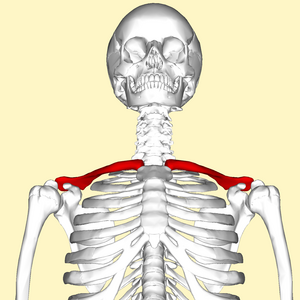Clavicle
Original Editor - Natalie Patterson
Top Contributors - Sehriban Ozmen, Natalie Patterson, Kim Jackson, Chelsea Mclene, Admin, Feride Orman and Lucinda hampton
This article is currently under review and may not be up to date. Please come back soon to see the finished work! (21/12/2023)
Description[edit | edit source]
The Clavicle also known as the collar bone, is a sigmoid-shaped long bone[1] that makes up the front part of the shoulder. It sits between the shoulder blade and the sternum. There are 2 clavicles in a person, one on the right and the other one on the left side. It is the only long bone in the body that lies horizontally.
Articulations[edit | edit source]
Due to the clavicle’s structure, there are only two planar diarthrosis articulations that can be found. This type of articulation is also known as a ‘double plane joint’ – where two joint cavities are separated by a layer of articular cartilage.
The Acromioclavicular joint: The articulation between the clavicle and the Scapula.[2]
The Sternoclavicular joint: The articulation between the clavicle and the Manubrium.[2]
Acromioclavicular Joint (Articulatio acromioclavicularis)[edit | edit source]
This is articulation between the acromial end of the clavicle and the acromion of the scapula. It enables slight gliding movement about the shoulder region. It is a synovial joint surrounded by a capsule of articular cartilage filled with intra-articular synovium.[3]
Sternoclavicular Joint (Articulatio sternoclavicularis)[edit | edit source]
This is the articulation between the sternal end of the clavicle and the manubrium of the sternum. This synovial joint is important as it attaches the clavicle and scapula to the axial skeleton. The joint enables a variety of limited movements of the arm, including:
- Protraction and retraction
- Elevation and depression
- Axial rotation
Muscle Attachments[edit | edit source]
A total of five muscles are attached to the clavicle, found distributed at either the lateral third or medial two-thirds of the bone.
Two muscles are attached to the lateral third of the clavicle:
- The trapezius muscle, which is attached along the posterior surface of the lateral third of the clavicle.
- The deltoid muscle, where the anterior portion of the muscle is attached to the periosteum at the anterior surface of the bone.
Three muscles are attached to the medial third of the clavicle:
- The sternocleidomastoid muscle, the clavicular head of the muscle attaches to the medial third of the clavicle.
- The pectoralis major muscle, which is attached to the anterior surface of the bone.
- The subclavius muscle, which is attached to a groove found in the middle of the bone’s inferior surface. From there, the muscle extends into both lateral and medial areas of the clavicle.[3] It's action is to draw the clavicle downwards and forward[2]
Among them, deltoid and trapezius muscles provide the dynamic stability of the acromioclavicular joint. [4]
Ligaments[edit | edit source]
The acromioclavicular joint (AC) is stabilised by the acromioclavicular capsule and ligaments (mainly in the horizontal direction), and the coracoclavicular ligament (mainly in the vertical direction). [4]
The coracoclavicular ligament consists of two ligaments; trapezoid and conoid ligaments. These two ligaments are distinct in anatomy and function. The trapezoid ligament is larger and roughly quadrilateral in shape, inserts onto the distal clavicle along the trapezoidal line/ridge and restrains posterior clavicular displacement and AC compression; while the conoid ligament is conical in shape, nearly vertical, located posteromedial to the trapezoid ligament and restraining superior migration of the clavicle. [4]
Clinical Relevance[edit | edit source]
- The clavicle plays an essential role in functional movement, serving as the connection between the axial skeleton and the pectoral girdle. This allows the clavicle to act as a brace for the shoulder, allowing weight to be transferred from the upper limbs to the axial skeleton.[3]
- The clavicle plays a protective role for neurovascular structures entering the thorax (for example brachiocephalic arterial trunk, internal jugular vein, common carotid artery, vagus and phrenic nerves) along with the sternum. [5]
- The clavicular fracture (broken collar bone) is most commonly caused by a fall or blow to the shoulder. It is usually managed with conservative management of wearing a sling and rest. If the fracture results in the bone piercing the skin surgery will be considered to fit a plate with screws. [6]
- Also check the related Acromioclavicular Joint Disorders and Sternoclavicular Joint Disorders pages to gain more insight into the clinical anatomy of the clavicle.
Physiotherapy Relevance[edit | edit source]
Acromioclavicular joint mobilisation: As a manual therapy method applied by a physiotherapist, when added to standard physical therapy in frozen shoulder patients, it is more effective in improving outcomes such as pain, disability and active abduction range of motion than standard physical therapy alone. [7]
Resources[edit | edit source]
References[edit | edit source]
- ↑ Hyland, S and Varacallo, M. Anatomy, Shoulder and Upper Limb, Clavicle. Available from https://www.researchgate.net/publication/329717390_Anatomy_Shoulder_and_Upper_Limb_Clavicle Accessed 20 July 2020
- ↑ 2.0 2.1 2.2 The Essential Anatomy 5 App [Mobile application software]. (Version 5.0.8). 3D4Medical (2019). Accessed 20 July 2020
- ↑ 3.0 3.1 3.2 Kenhub. Clavicle. Available from: https://www.kenhub.com/en/library/anatomy/the-clavicle (Accessed 26 July 2020)
- ↑ 4.0 4.1 4.2 Flores DV, Goes PK, Gómez CM, Umpire DF, Pathria MN. Imaging of the acromioclavicular joint: anatomy, function, pathologic features, and treatment. Radiographics. 2020 Sep;40(5):1355-82.
- ↑ Epperson TN, Varacallo M. Anatomy, shoulder and upper limb, sternoclavicular joint.
- ↑ NHS. Broken collarbone. Available from: https://www.nhs.uk/conditions/broken-collarbone/ (accessed 20 July 2020)
- ↑ Rahbar M, Ranjbar Kiyakalayeh S, Mirzajani R, Eftekharsadat B, Dolatkhah N. Effectiveness of acromioclavicular joint mobilization and physical therapy vs physical therapy alone in patients with frozen shoulder: A randomized clinical trial. Clinical Rehabilitation. 2022 May;36(5):669-82.







